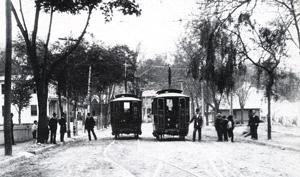Derby History QuizCurrent Quiz Archives of all quizzes
This was a passing siding on Derby Avenue. The world's first standard-gauge electric freight locomotive was put into service on the Derby Horse Railway, between the Derby Dock and Ansonia. The electrification of this line was commenced by the Van Depoele Electric Mfg. Co. and completed by the Thomson-Houston Electric Co. which had taken over the railway business of the first firm. The locomotive is preserved at the Shore Line Trolley Museum, East Haven, Connecticut. - from "The Derby Horse Railway and the World's First Electric Freight Locomotive" by John R. Stevens c1987, for the New Haven Colony Historical Society. Also, according to the book: The reason for the inception of the electric freight operation as principally being the discriminatory treatment, in terms of freight rates, being given the firm of Merritt Clark's Sons - and presumably others as well. The Clarks were coal merchants. In 1884, the Naugatuck Railroad took over of the New Haven and Derby Railroad, which also served the area, thus removing the competition. William J. Clark, of Merritt Clark's Sons proposed the Derby Horse Railway primarily as a freight carrier to compete with the steam railroad. The State of CT approved the charter on March 19, 1885. In the process of raising the money to build the line, H. Holton Wood, General Manager of the Staten Island Rapid Transit Co., was approached. He in turn asked the chief engineer of his line for advice as to motive power, and electricity was recommended. The electric line under construction in Scranton, PA by the Van Depoele Electric Manufacturing Co., was cited as an example. William Wallace, the pioneer electric manufacturer in the United States (he supplied Thomas Alva Edison with the dynamo used by Edison for his first incandescent electric light experiments) was asked for his opinion on the use of electric traction, and Wallace enthusiastically endorsed it. The railway's charter was ammended to this end on March 16, 1887. In April, Mr. Wallace, acting for the company, entered into a contract with the Van Depoele company. The cost of the electrical equipment, including the setting of poles and rolling stock was $20,225.00. Much of this account is directly quoted from remarks supplied in the winter of 1924-25 by James D. Kennedy, then 70 years old, who superintended the construction of the line. Kennedy had performed the same role for the line in Scranton. Kennedy remained with the Derby Horse Railway until July, 1888, when he resigned to work for the Thomson-Houston Electric Co., then constructing an electric line in Lynn, Mass. Later he became Roadmaster for the Derby division of the Connecticut Co. Kennedy remarked that sections fo the track, in Ansonia and Birmingham were constructed with strap rails laid on longitudinal stringers. Mr. Kennedy was a hard-driving man, and the tactics used by him and his Irish laborers to beat out the Derby and Ansonia Horse Railroad Co., while humorous, would hardly be tolerated today. Where the two companies shared the same streets in Ansonia and Birmingham, Kennedy managed to have the Derby Horse Railway's track occupy the center of the roadway, thus forcing the other company to use the side of the road. Work on track construction in the disputed areas was started one night without advance warning, in order to obtain the preferred location. The first track laid was built to strategically block the other company. Stealth and lying were part of the procedure, and where this failed, resort was made to pickaxe handles! A group of 60 Italian laborers, coming from New York by steamboat to work for the rival company was intercepted, and ended up in Waterbury! Needless to say, Kennedy was successful in his efforts. An article in the Hartford Daily Times of May 23, 1888 stated that when the construction of the electric line was announced, the two steam railroads serving the area issued a circular notifying manufacturers and merchants of Ansonia that they were reducing rates by 25%. They had been receiving $1,000,000 a year for freight transportation. The article claimed that the electric line, only in operation a few weeks - and on which electric freight service had not yet begun - already had saved area shippers $250,000. There is also a good article on the Derby Street Railway Co., in the 1896 Souvenir History of Derby and Shelton book. To see our other earlier quizzes and learn more about Derby's unique history, click here.
|
